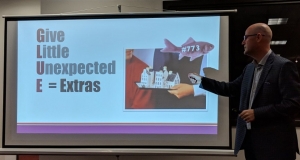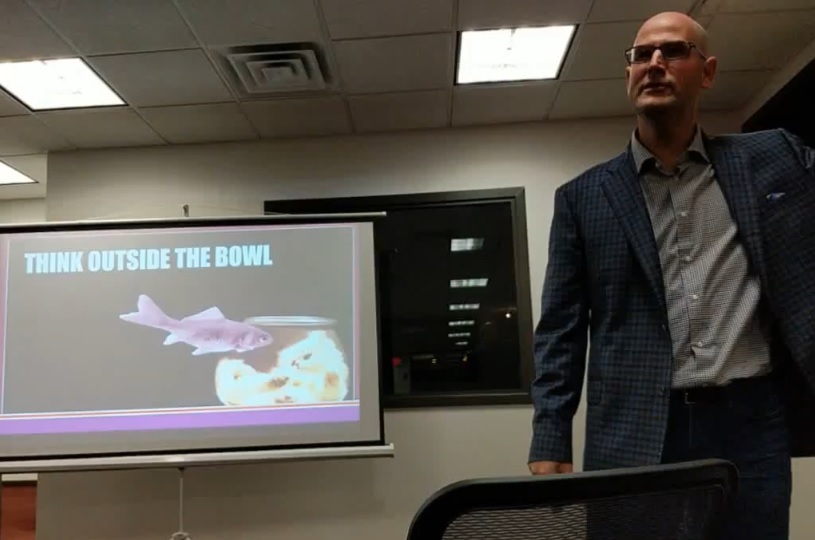On Tuesday, February 21, 2017, AMA Boston members and guests were treated to a very insightful presentation from Stan Phelps, a TEDx speaker and IBM futurist, about the importance of “little things” to the customer experience. Prior to Stan’s talk, there were introductions from AMA Boston President-Elect Bob Cargill and President Bonnie Akerson, who also announced exciting upcoming events and congratulated Maggie Newberg, the chapter’s latest “Blogger of the Quarter” winner.
The Growing Importance of Customer Experience
Stan notes that the most significant success factor for brands is to get into people’s hearts by being authentic and emotional. Offering an outstanding customer experience is more important than ever. Today, 89% of companies compete on customer experience versus only 36 % five years ago. In his great speech, Stan presented key ways on how to achieve outstanding customer experience by reaching the heart of customers. Throughout his presentation, he elaborated on key drivers of success and watch-outs by show-casing along various examples for leading customer experience across industries leveraging insights from his analysis of more than 1,000 customer experience examples during his “purple goldfish project”.
Stan kicked-off the session with an example of how Panera Bread managed to achieve outstanding customer experience by going the extra mile for their customers. Achieving high perceived “warmth” and “competence” was key for Panera, also building the foundation for great customer experience. In the example, Panera garnered 810,000 social media mentions on a comment about a unique positive customer experience that went viral (unexpected little extra service for a customer – fulfilling the last wish of a customer by serving clam chowder outside the regular hours).
In this example, customer expectation/demands were exceeded, a major step for organizations, according to Stan. Meeting customer demands is actually more a myth than reality, Stan further points out that “Either companies exceed customer expectations or they fall short, but they never just meet them.” So, how to achieve best customer experience and exceed customer expectations? According to Stan, it’s following the “Purple Goldfish” approach.
Why Goldfish?
Inspired by his experience at Kimpton hotels, an extra ordinary service, higher-class hotel, Stan refers to one of Kimpton’s signature customer service amenities: offering a goldfish to stay within the guest room for the duration of the stay. Giving something extra and unexpected to a customer, like in this case, drives the overall positive experience of a customer.
Why Purple?
One of the key colors of New Orleans’ Mardi Gras event is purple, representing the outstanding nature of this event and its connection to Cajun cultures which use the word Lagniappe (stands for: “giving a bit more”) as part of the New Orleans festivities. Providing something “extra” is the key for leading customer experience, according to Stan.

Diving into the Goldfish Principal
But, there is more to the “Goldfish principle”, as Stan further highlighted. There are five key analogies, between the goldfish and key factors for companies to be successful and to grow:
- Market size: the larger the market (the pond) the better the growth opportunities
- Competition: more competitors (number of goldfish) force companies to grow and become better
- State of economy: current market condition (clarity of the water) drives buying behavior
- New products: re-inventing yourself and the ability to successfully launch products in first months after launch (fragility of baby fish) determines future success
- Differentiation: ability to stand-out from the pack (very different type of goldfish)
Only the factor of “Differentiation” is the one which can really be influenced by companies and setting the scene for successful customer experience as key driver for a company’s success.

Diving deeper here, Stan referred to his “purple goldfish project, revealing 12 ways to differentiate. Either you differentiate around “value” or around “maintenance.” But how to get there? Stan’s “3D” framework allows companies to manage customer experience holistically:
- Discover => Identify key potential differentiators
- Design => Create road-map by planning and designing a designated customer experience journey
- Deploy => Build capabilities (e.g. train front line) and install customer experience processes; control/ potentially adjust.
One example, among various: Stan show-cases Southwestern Airline which follows a clear customer experience strategy to differentiate itself. They are best in things customer value most e.g. good price, friendly service and less focused on things which matter less to customers e.g. extensive network or on-board amenities.
These examples also point out that as a company, you should know your customers and their demands well as and you should not treat every customer the same way. Unsurprisingly, research shows that ~80% of a company’s profit comes from ~20% of its customers.
In the example of the brand Velveeta, a turnaround was successfully achieved by focusing on existing, loyal key profit-delivering customers only, which represented by just 15% of total customers. Furthermore, Stan emphasized the importance of loyal life-time customers, as they are the most valuable ones; four times more valuable than other customer as they act as brand ambassadors, refer the product and are likely to spend more over time than 
Stan concluded his presentation with two key take-aways for driving a great customer experience: always exceed expectations and think outside the box to differentiate.
AMA Boston would like to thank Stan, G-Tek Labs for the use of their fine space, and all the attendees for making this another terrific event!






